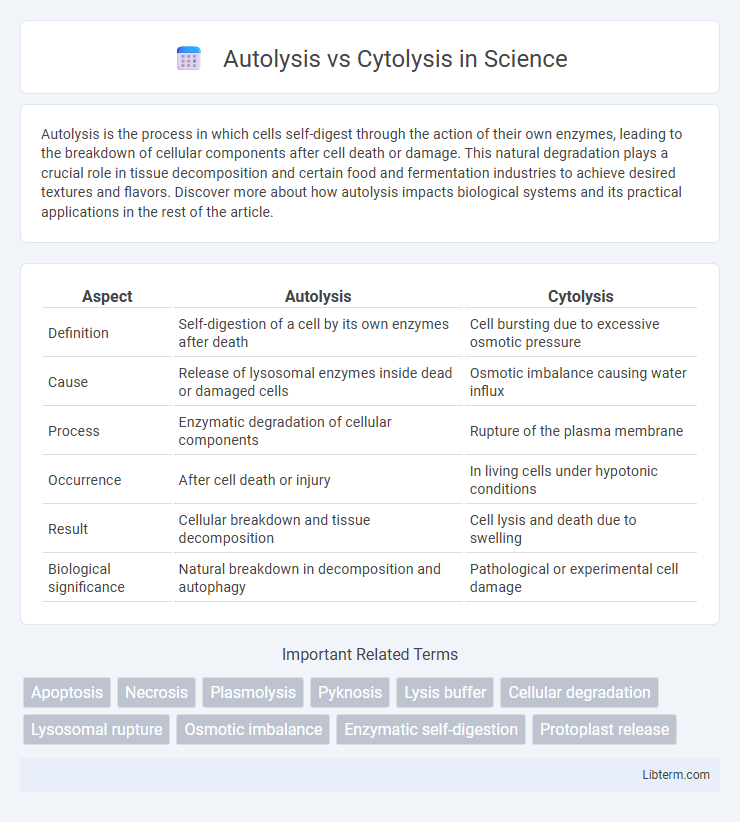Autolysis is the process in which cells self-digest through the action of their own enzymes, leading to the breakdown of cellular components after cell death or damage. This natural degradation plays a crucial role in tissue decomposition and certain food and fermentation industries to achieve desired textures and flavors. Discover more about how autolysis impacts biological systems and its practical applications in the rest of the article.
Table of Comparison
| Aspect | Autolysis | Cytolysis |
|---|---|---|
| Definition | Self-digestion of a cell by its own enzymes after death | Cell bursting due to excessive osmotic pressure |
| Cause | Release of lysosomal enzymes inside dead or damaged cells | Osmotic imbalance causing water influx |
| Process | Enzymatic degradation of cellular components | Rupture of the plasma membrane |
| Occurrence | After cell death or injury | In living cells under hypotonic conditions |
| Result | Cellular breakdown and tissue decomposition | Cell lysis and death due to swelling |
| Biological significance | Natural breakdown in decomposition and autophagy | Pathological or experimental cell damage |
Introduction to Autolysis and Cytolysis
Autolysis is the self-digestion process where a cell breaks down its own components through the action of its enzymes after death or injury. Cytolysis refers to the disruption or rupture of a cell membrane resulting in the release of cellular contents, often caused by osmotic imbalance or immune response. Both processes involve cellular degradation but differ in mechanisms and triggers, with autolysis being an intrinsic enzymatic activity and cytolysis typically resulting from external factors.
Defining Autolysis: Self-Destruction in Cells
Autolysis refers to the self-destruction process in cells where lysosomal enzymes break down cellular components after cell death, ensuring the degradation of cellular materials without external factors. Unlike cytolysis, which involves the rupture of a living cell due to osmotic imbalance, autolysis is an internally programmed disintegration mechanism triggered after cellular demise. This intrinsic enzymatic degradation plays a critical role in tissue remodeling and the elimination of damaged cells in multicellular organisms.
Understanding Cytolysis: Cell Bursting Explained
Cytolysis is the process where a cell bursts due to an influx of water, causing the plasma membrane to rupture from osmotic pressure. This phenomenon commonly occurs in hypotonic environments where water moves into the cell, overwhelming its structural integrity. In contrast, autolysis is a self-digestion process where lysosomal enzymes break down cell components after cell death, without causing immediate membrane rupture.
Key Differences Between Autolysis and Cytolysis
Autolysis is the self-digestion process where a cell's own enzymes break down its components after cell death, whereas cytolysis involves the destruction of a cell caused by an external factor leading to osmotic imbalance and cell bursting. Autolysis occurs internally within a cell without external influences, while cytolysis results from external osmotic pressure changes causing water influx. The key difference lies in autolysis being enzymatic self-degradation post-mortem, and cytolysis being physical cell rupture due to external osmotic stress.
Mechanisms Behind Autolysis
Autolysis involves the self-digestion of a cell through the release of its own lysosomal enzymes, leading to the breakdown of cellular components. This process is triggered when cellular membranes become permeable due to injury or death, allowing hydrolases like proteases, nucleases, and lipases to degrade proteins, nucleic acids, and lipids. In contrast, cytolysis results from external factors causing cell membrane rupture and uncontrolled release of intracellular contents.
Causes and Triggers of Cytolysis
Cytolysis is primarily triggered by osmotic imbalance leading to excessive water influx, causing the cell membrane to rupture, often resulting from hypotonic environments where extracellular fluid has lower solute concentration. In contrast, autolysis occurs due to the release of lysosomal enzymes within a damaged or dying cell, initiating self-digestion without external osmotic influence. Key causes of cytolysis include viral infections, immune responses, and exposure to toxins that disrupt membrane integrity and ion channels, promoting cellular swelling and lysis.
Biological Significance of Autolysis
Autolysis is a self-degradation process where lysosomal enzymes break down cellular components after cell death, crucial for recycling nutrients and maintaining tissue homeostasis. Unlike cytolysis, which results from external osmotic imbalances causing cell rupture, autolysis facilitates the removal of damaged or dead cells without triggering inflammation. This regulated enzymatic activity supports cellular turnover and plays a vital role in processes such as development, wound healing, and pathogen defense.
Physiological Roles of Cytolysis
Cytolysis plays a critical physiological role in maintaining tissue homeostasis by eliminating damaged or infected cells through membrane rupture, thereby preventing the spread of harmful agents. It facilitates immune system functions by allowing the destruction of pathogenic cells via complement-induced cytolytic activity. Unlike autolysis, which is a self-degradation process post-cell death, cytolysis actively contributes to cellular turnover and defense mechanisms in living organisms.
Clinical and Research Implications
Autolysis, the self-digestion of cells by their own enzymes, complicates tissue sample integrity in histopathology, often producing false-positive results or obscuring cellular details critical for accurate diagnosis. Cytolysis, involving the rupture of cell membranes due to external causes like viral infection or immune responses, is a key indicator in assessing inflammatory diseases and pathogen-induced tissue damage in clinical research. Understanding the distinct enzymatic and structural mechanisms between autolysis and cytolysis aids in optimizing sample preservation techniques and advancing targeted therapeutic strategies in biomedical investigations.
Summary: Comparing Autolysis vs Cytolysis
Autolysis is the self-digestion of cells through endogenous enzymes, primarily occurring after cell death, while cytolysis involves the destruction of cells caused by external factors such as osmotic imbalance or immune responses. Autolysis plays a crucial role in tissue breakdown during decomposition, whereas cytolysis often results from pathological conditions like viral infections or immune system attacks. Understanding the mechanisms and causes of autolysis and cytolysis is essential for analyzing cellular damage in medical and biological contexts.
Autolysis Infographic

 libterm.com
libterm.com